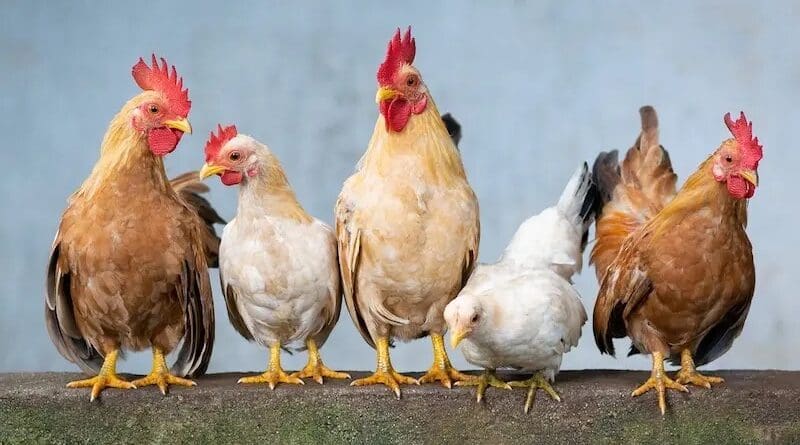Human and animal health are closely linked, with many diseases shared between them. As our world becomes more developed and interconnected, the proximity between wild animals and humans is shrinking, increasing the risk of disease transmission. At the same time, humans are growing increasingly dependent on animals as a source of food.
The emergence of new diseases is an unfortunate byproduct of these trends. According to the World Health Organization, most of the newly discovered diseases in humans—about 75 percent—have originated in animals in the last three decades. Scientists call these kinds of diseases “zoonotic.”
As humans navigate the growing risk of zoonotic diseases, it is essential to understand how reversing our dependence on meat, dairy, and other animal products can help have a positive impact on our health and that of the planet, while ensuring a better life for the animals.
What Is a Zoonotic Disease?
A zoonotic disease is a disease that transfers from an animal population to humans. According to the Centers for Disease Control and Prevention, zoonotic diseases are caused by germs such as bacteria, viruses, parasites, and fungi. Many different types of zoonotic diseases cause human illnesses that range from mild to life-threatening in severity.
It is estimated that six out of ten known infectious diseases that have been reported globally have spread between animals and humans, according to the World Health Organization—and zoonoses are only becoming more frequent.
What Causes Zoonoses?
Humans worldwide live near wild and domesticated animals, largely thanks to our food system’s reliance on industrial animal agriculture. As we navigate the challenges posed by this “unsustainable agricultural intensification”—that is “[destroying] the natural buffers that protect humans from viruses circulating among wildlife,” according to the United Nations—health experts say it has become crucial to understand how zoonotic diseases can spread.
Direct Contact
Diseases can pass from animals to humans who come in direct contact with them by touching an infected animal, for example, or being bitten by one. Zoonotic diseases usually spread through direct contact with an infected animalʼs bodily fluids, such as urine, blood, saliva, feces, or mucus.
Indirect Contact
Humans can also become infected in an animalʼs habitat or living quarters. For example, zoonoses can spread to a human while cleaning out an aquarium or chicken coop or while handling a petʼs food and water dishes. On industrial chicken farms, birds live in squalid conditions with the floor drenched in urine and feces, leading to the ideal conditions for animals to get sick.
Vector-Borne
In epidemiology, a “vector” usually refers to insects, arachnids, and other small organisms that spread an infection from one host to another.
An infected tick, for instance, can attach to a human and transmit Lymes disease. This is also why mosquito bites can potentially cause severe illnesses like the Zika virus, malaria, and yellow fever.
Foodborne
Foodborne diseases, or food poisoning, can be caused by eating raw or undercooked animal products. Eggs and chicken are among the most common sources of food poisoning. Salmonella and campylobacter—from raw eggs and chicken—are common zoonotic diseases. Chickens are among the most widely farmed land animals in the U.S. and worldwide. The U.S. raised more than 9 billion chickens for meat in 2020 alone.
Waterborne
Consuming water contaminated with harmful bacteria can cause illness in humans. For example, lakes, rivers, and streams contaminated with animal waste might have elevated levels of E. coli bacteria—found in the fecal matter of warm-blooded animals.
E. coli contamination is one reason why factory farms can have devastating impactson neighboring water bodies. If ingested by humans, the contaminated water can cause anything from minor stomach discomfort to serious health problems or even death.
How Do Zoonotic Diseases Spread Between Animals and People?
There are many ways for zoonotic diseases to spread between animals and people. However, public health researchers have found a common thread through many of the primary drivers of zoonotic diseases. Namely, factory farming and the consumption of animals around the world are sharply driving up the risks that could cause the next significant outbreak.
Farming and Ranching
By a conservative estimate, the agricultural industry has been responsible for around half of all new zoonotic diseases since 1940, according to a November 2022 paper in Science Advances. Epidemiologists say that percentage is probably higher. Nearly every aspect of intensive animal farming contributes to conditions ideal for spreading disease—overly stressed animals, who often live in sordid conditions and are crowded into tight spaces with one another, regularly come into contact with human workers.
Intensive animal farming creates a perfect storm for spreading zoonotic disease.
Wildlife Trade
In addition to animal agriculture, both the legal and illegal wildlife trade—which refers to the global commerce of non-domesticated animals and plants—are serious drivers of zoonotic disease.
A 2021 study published in Current Biology found that more than 25 percent of the mammals in the wildlife trade host 75 percent of all known zoonotic diseases. Because the complex process of transporting these animals results in “upward of 1 billion direct and indirect contacts among wildlife, animals, and domestic animals,” the studyʼs lead author, K. Nagaraju Shivaprakash, concluded that “[W]ildlife trade… is [conceivably] a significant factor in the global spread of zoonotic and emerging infectious diseases.”
Animal Captivity
Holding animals in captivity and exploiting them for human entertainment poses many ethical and moral problems. Animals in captivity also pose public health risks. Petting zoos and other animal exhibits where humans can directly touch captive animals are particularly concerning. Between 1990 and 2000, more than 25 zoonotic outbreaks were linked to animal exhibits, according to 2007 figures provided by the CDC.
Insect Vectors
There are more than a billion insects for every human on Earth. While these tiny beings are essential to our survival, some can also carry deadly diseases.
Ticks, fleas, and female mosquitoes (male mosquitoes don’t bite) can cause various illnesses, most of which are now treatable. However, one of the worst pandemics in history, the Black Plague, has been traced back to infected fleas.
Deforestation and Habitat Destruction
Deforestation and habitat destruction—primarily driven by the agriculture industry—pose serious environmental risks. When wild animals see their habitats destroyed, they have no choice but to uproot and search for a new home. As they make these journeys, they are more likely to “bump into” other animals, increasing the chances for a once-contained disease to spill over to another population.
Climate Change
For reasons similar to habitat destruction, scientists say climate change is already increasing the chances of humans experiencing more frequent zoonotic pandemics. “Using recent estimates of the rate of increase in disease emergence from zoonotic reservoirs associated with environmental change, we estimate that the yearly probability of occurrence of extreme epidemics can increase up to threefold in the coming decades,” warns a 2021 article in the Proceedings of the National Academy of Sciences.
Animal agriculture contributes more global greenhouse gas emissions than the transportation sector.
The resulting extreme heat at the equator caused by global warming has many species racing toward the poles for more hospitable climates. This has prompted once-remote animal species to travel great distances, likely increasing their chances of contact with humans and other animals and potentially spreading disease.
Contaminated Food and Water
Food or water that has been contaminated by a bacterium, virus, or parasite leads to tens of millions of annual food poisoning cases and more than 1,000 deaths in the United States alone, according to the CDC.
Norovirus is the leading cause of foodborne illness-related deaths in the U.S. After that, salmonella, C. perfringens, and campylobacter are the next most fatal pathogens. “Campylobacteriosis is the most commonly reported gastrointestinal disease” in the European Union, with more than 129,000 cases reported in 2021, which is a 5.6 percent increase compared to 2020.
The European Centre for Disease Prevention and Control found that chickens and chicken meat accounted for roughly 20 to 30 percent of these human infection cases.
How Are Zoonoses Classified?
Public health experts classify zoonoses by their root cause. In other words, the disease pathogen could be a bacterium, a virus, or something else.
Bacterial Zoonoses
Bacterial zoonoses are diseases caused by single-cell microorganisms found almost everywhere on Earth and inside the human body. Most bacteria are harmless or even helpful, and relatively few cause disease.
Viral Zoonoses
Viral zoonoses are diseases caused by viruses, which are infectious microbes made up of DNA or RNA surrounded by a “protein coat.” They can infect humans, other animals, plants, fungi, and bacteria.
Parasitic Zoonoses
Parasitic zoonoses are diseases caused by parasites that attach themselves to or are found inside a hostʼs body. Parasitic diseases can spread from animals to humans through the consumption of raw or undercooked meat or by consuming food or water contaminated by an infected animalʼs stool.
Fungal Zoonoses
Fungal zoonoses are diseases caused by fungi, spore-producing organisms such as molds, yeasts, and mushrooms. Fungi can cause topical infections on a person’s body (such as skin rashes and brittle nails) or inside the body (such as infections of the lungs or bloodstream).
Rickettsial Zoonoses
Rickettsial zoonoses are diseases caused by an unusual type of bacteria that can live only inside the cells of other organisms. Rickettsial infections are usually transmitted to humans through bites from vectors such as ticks, lice, fleas, and mites.
Chlamydial Zoonoses
Chlamydial zoonoses are diseases caused by a family of bacteria called chlamydiae, one of the most common infectious agents affecting humans. One type of the bacteria is frequently transmitted in people as a sexually transmitted infection—and is often referred to colloquially as chlamydia. Another version, however, affects domesticated birds and can spread to humans when handling their birds or cleaning out their cages.
Mycoplasma Zoonoses
Mycoplasma zoonoses are diseases caused by an atypical family of bacteria that are harder to kill through antibiotics. Mycoplasma pneumoniae can infect the human respiratory system—a mild form of pneumonia is often called “walking pneumonia”—and spreads through tiny droplets from coughs and sneezes. There have also been reported cases of this sort of bacteria spreading from animals to humans.
Protozoal Zoonoses
Protozoal zoonoses are diseases caused by protozoal parasites and often spread from companion animals to their owners. Many humans are protected from these types of diseases by strong immune systems. However, immunocompromised pet caretakers are at a much higher risk.
Acellular Non-Viral Pathogenic Zoonoses
Acellular non-viral pathogenic zoonoses refer to diseases caused by very unusual and not well-understood pathogens, such as prion, a misfolded protein. Prion is believed to be the cause of neurological disorders such as mad cow disease and similar diseases affecting the brains of humans.
Zoonotic Disease Examples
Avian Influenza
Avian influenza, or bird flu, is a viral disease that primarily affects wild waterfowl and domesticated poultry. As of April 10, 2024, more than 85 million poultry have been affected by a bird flu outbreak, the majority of which were egg-laying hens raised in cramped cages. While it has infected humans in rare cases, given the ongoing, severe outbreak in both wild and domestic bird populations, public health experts are concerned about more potential spillover events in the near future.
Due to the sheer number of birds we factory farm, we are dramatically increasing this risk. Keeping birds in closed confines, filthy conditions, and continually stressed is the perfect environment for bird flu to flourish.
Salmonellosis
Salmonellosis is caused by an infection from salmonella bacteria, which live in the digestive tracts of birds and other animals. Humans risk infection if they do not practice good hand-washing habits and consume raw eggs, unpasteurized dairy products, or undercooked meat.
Psittacosis
Humans can contract psittacosis from infected pet birds, such as parrots and cockatiels, or domesticated poultry, such as chickens and turkeys. The illness is usually quite mild and relatively brief in humans.
Rabies
Rabies is a viral disease that can affect any mammal but is most associated with bats, raccoons, skunks, foxes, and dogs. Rabies is usually transmitted to humans through the bite of an infected animal. The infection affects the central nervous system and is nearly always fatal once symptoms are present.
Cat Scratch Disease
Cat scratch disease is a bacterial infection. It can spread to humans when a cat licks an open wound or scratches a person deep enough to break the skin. The infection can cause redness around the site of the wound, swollen glands, and flu-like symptoms. While the symptoms are usually mild, in rare cases, the infection can become serious if it spreads to other organs.
Malaria
Malaria is a disease caused by a parasite that spreads to humans through mosquito bites. If it is left untreated, malaria can be fatal, especially in children under five. The disease is most commonly found in countries near the equator, especially in sub-Saharan Africa and Oceania.
Zika Virus
Mosquito bites are the most common cause of the Zika virus. However, it can also be passed from a pregnant mother to her child or through sexual contact. The virusʼ symptoms usually include mild rash and illness. However, it can cause serious congenital disorders in newborns.
Lyme Disease
Lyme disease is the most common vector-borne zoonoses in the U.S. It is caused by infected blacklegged tick bites. While relatively easily treatable, if left untreated, Lyme disease can result in prolonged pain, stiffness, and swelling, as well as memory problems and difficulty concentrating.
Bubonic Plague
Responsible for the most infamous pandemic in history—known as the Black Plague or Black Death—the bubonic plague still crops up in some cases worldwide. However, outbreaks of this bacteria-borne zoonotic disease can be controlled with antibiotics.
Swine Flu
Also known as the H1N1 flu, swine flu is caused by an influenza virus that began infecting humans in 2009, causing a pandemic in humans, pigs, and birds. Pigs with swine flu may develop symptoms ranging from fever, coughing, and sneezing to depression and a lack of appetite. Humans can get sick from being near pigs on farms or at county fairs.
COVID-19
Scientists agree the COVID-19 pandemic originated from a nonhuman animal. However, there is yet to be a definitive conclusion about the source. According to WHO, the leading theory is that the COVID-19 virus originated in bats and spread to humans via another animal.
Who Is at Risk of Zoonotic Diseases?
As the far-reaching effects of COVID-19 have taught us, no one is immune from getting a zoonotic disease. However, various risk factors can put certain people at higher risk of infection than others.
According to the CDC, children under five, adults more than 65 years old, those with weakened immune systems, and pregnant women are at heightened risk of serious illness from zoonotic diseases.
What Can You Do to Protect Yourself from Zoonotic Diseases?
Animals are all around us, whether they are buzzing around us outdoors, wandering through our backyards, or even living inside our homes. This means there is always a chance of a bacterium, virus, or other pathogen jumping from an infected animal to one of us.
The CDC has laid out a practical list of ways to protect ourselves from preventable zoonotic diseases:
+Wash your hands after touching animals or animal products. Soap and running water for 20 seconds is one of the most effective ways to stop the spread of germs. If soap and water arenʼt available, using a hand sanitizer that contains at least 60 percent alcohol is the next best thing.
+ Avoid tick, flea, and mosquito bites outdoors by wearing bug spray and long-sleeved clothing and paying attention to CDC health warnings in your area.
+ If you have companion animals in your home, educate yourself about what diseases typically affect them and how to keep them healthy.
+Be wary of animal exhibits and petting zoos.
However, the rise of industrial animal agriculture over the 20th century has transformed our food system into one in which thousands of animals are packed into dense, unclean living quarters—creating conditions ripe for disease. While taking individual precautions to avoid contracting zoonoses is essential, the threat remains high unless we collectively change our relationship with nonhuman animals.
Preventing Zoonotic Disease Globally
Public health experts agree that the world needs to address the primary root cause of emerging zoonotic diseases: animal consumption. A 2022 research article in the journal Science Advances explains that changing how we raise animals for meat is insufficient to stem the accelerated rise in these diseases.
Intensive agriculture is the leading cause of deforestation, which drives the global spread of disease. To further increase productivity, animals are increasingly kept in more intensive systems, but this process involves confining animals—and their waste—together into tight spaces. Not only is this inhumane, but in such large numbers and under so much stress, it also greases the wheels for the spread of disease.
Research shows that slowing the spread of zoonotic diseases will require reducing global reliance on animal products as a food source while accelerating forest conservation efforts worldwide.
Ending Intensive Animal Agriculture
Much work remains to end intensive animal agriculture and make the world a safer place for humans and nonhuman animals.
We must hold corporations and elected officials accountable for how their actions affect nonhuman animals’ well-being and public health. Governments must stop subsidizing animal agriculture and instead support more sustainable farming practices.
More awareness is also required to educate people about the atrocities inflicted on animals to support intensive farming and to highlight the overall environmental and health benefits of moving toward a plant-based diet.
###
This article was produced by Earth | Food | Life, a project of the Independent Media Institute.














